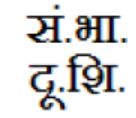 |
Distance Learning Program (DLP) - दूरस्थशिक्षणम् |
 |
DLP Syllabus for Adult Track
The coursework in each level covers grammar/syntax, shlokas/puzzles, vocabulary and information on the Sanskrit heritage. In addition, there is text material that contains stories from various works of Samskritam literature. The student is expected to not only learn the grammar but also other aspects that have been mentioned above as they will be tested on all of the materials.
We have additionally split the syllabus into two logical parts to help students focus on a subset, gain proficiency, and be tested on this subset before moving to the second part. The certificate, though, is given for the whole exam. Currently, this split syllabus has been implemented for the Pravesha and Parichaya levels.
1 Pravesha
Medium of Instruction is English. But, the answers are expected to be written in Samskritam unless otherwise stated. The Samskritam is expected to be in Devanagari.
Pravesha (grammer portion) broadly covers the following topics:
- Study and use of Devanagari script (I)
- Declensions of masculine feminine and neuter genders for vowel (and some consonant) ending nouns (I)
- Declensions of various pronouns (I)
- Syntax and usages of all seven declensions (I)
- Numerals (I)
- Tenses (Present*, Past, Future and Imperative), in both parasmai padi* and atmane padi forms (II) (*Present tense parasmaipadi verbs (I))
- Introduction to verb classification (II)
- Past participle, infinitives (II)
- Prefixes (II)
- Buy Pravesha books
1.1 Pravesha-Part-I (प्रवेशः - पूर्वभागः) &Pravesha-Part-II (प्रवेशः - उत्तरभागः): To view the syllabus please click DLP Split Syllabus
2 Parichaya
Medium of some of the Instructions is in English. But, the answers are expected to be written in Samskritam unless otherwise stated.
Parichaya builds upon the contents covered by Pravesha covering the following topics:
- Adjectives, and their usage
- Ordinals
- Sandhi (modification of the sound of a word or morpheme when juxtaposed with another or coalescence of letters)
- Indeclinables
- Potential mood
- How to rearrange a shloka to understand the verse meaning
- Passive construction and bhave usage
- Passive Participles and infinitives
- Buy Parichaya books
2.1 Parichaya-Part-I (परिचयः - पूर्वभागः) & Parichaya-Part-II (परिचयः - उत्तरभागः): To view the syllabus please click DLP Split Syllabus
3 Shiskha
Medium of the Instruction is primarily in Samskritam. Answers are expected to be written in Samskritam unless otherwise stated. Shiskha build upon the contents covered by Parichaya covering the following topics:
- Present Participles (shatru) their use and syntax in all Cases
- Sandhi ( advance study continued)
- Present Participles of Atmanei padi (Middle voice)
- Present Passive Participles (Shaanch) their use and syntax in all cases (declensions)
- Use of absolutives (Sati saptami)
- Detail rules of anvaya or process of rearranging a shloka for verse meaning
- Excerpts from Bhagavag Giita, and other famous Samskirtam literature
- Buy shiksha books
4 Kovida
Medium of the Instruction is primarily in Samskritam. Answers are expected to be written in Samskritam unless otherwise stated. Kovida build upon the contents covered by Shiksha covering the following topics:
- Compounds (the 5 groups, and sub classes along with their derivation and usage)
- Secondary Nominal bases ( taddhitaanta or secondary affixes)
- Passages from important Sanskrit literary authors using simple Sanskrit
- Biographies of important figures in Sanskrit literature
- Figures of speech (alankaras)
- Poetic Meters or Chandas
- Brief introduction to Sanskrit composition and letter writing
- Medium of Instruction is primarily Samskritam. But, the answers are expected to be written in Samskritam. The Samskritam is expected to be in Devanagari
- Buy kOvida books
